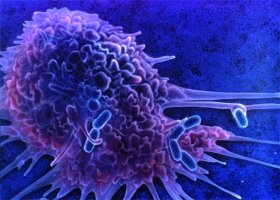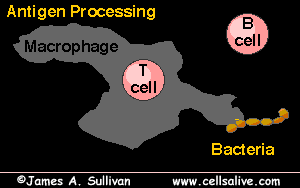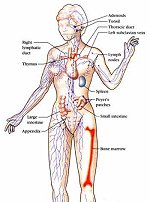|
Immune cells vs. invaders: it's
a war going on in every healthy human body. When the combatants
travel to space, say NASA scientists, curious things happen...
by Karen Miller
When you wake up, maybe
you yawn, switch off your alarm clock, and listen for the perking
of an automatic coffee maker -- a normal morning routine on Earth.
But if you were in orbit, the
first thing you'd do is take a little roll of cotton, swish it around
in your mouth, and then drop it in a tube filled with preservative.
The cotton collects viruses, and the goal of that good-morning ritual
is to help determine why astronaut saliva contains more viruses
in space than it does on the ground.
It's not a trivial question.
Our bodies are chock-full of tiny invaders: bacteria,
viruses, protozoans. Multitudes inhabit our gut, more slip in on
the food we eat and through the air we breathe. Usually they're
not a problem. Indeed, some are even helpful -- and the ones that
aren't are kept in check by our vigorous immune system, which marks
and destroys pathogens before they get out of control. Without immune
systems, humans would die.
In space, our immune system functions
differently. This complex system consists, essentially, of disease-fighting
cells that can travel throughout the body. There are many kinds
of immune cells; two of the most important are B-cells, which send
out antibodies -- proteins that latch onto germs or other problem-causing
invaders, flagging them as invaders to be destroyed, and T-cells,
which are the soldiers of the system, physically attacking and destroying
pathogens.

Credit and copyright: Scott
Barrows
Small,
capsule-shaped bacteria in this artist's rendering are being
"swallowed" by an immune cell's oozing outer membrane.
|
In space, these cells don't work the
way they do on the ground. T-cells, for example, don't multiply
properly; there aren't as many of them as there should be. They
can't move well. They don't signal each other as effectively. Overall,
they seem less able to destroy invading germs.
Here on Earth, doctors have learned
that stress can suppress the immune system by causing the body to
release hormones that affect the way T-cells behave. Likewise, the
unique physical and psychological stresses of space flight (takeoff
and landing, for example) might trigger immune-altering hormones.
Another possibility is that something about space itself -- weightlessness,
perhaps, and not hormones at all -- might affect immune cells directly.
To help solve the mystery,
researchers are using a NASA-developed "rotating bioreactor," which
provides a reasonable analogy of microgravity here on Earth. Neal
Pellis, chief of the Biological Systems Office in the Johnson Space
Centre, explains: The core of the bioreactor is a soup-can size
container that spins at the leisurely rate of 14 rpm. It allows
cells to remain suspended for months at a time in continual free
fall. Within their fluid environment, the tumbling cells fall toward
Earth as fast as they can -- just as they would in Earth orbit.

See the movie
and learn more
from CellsAlive.com
On Earth,
a smaller T-cell (arrow) attacks and kills a much larger influenza
virus-infected target.
|
Using the bioreactor, researchers can separate
the immune system from its hormonal controls. Rather than looking
at the human immune system as a whole, Pellis and his colleagues can
examine the possible effects of low-gravity on individual immune cells.
In the bioreactor, says Pellis, cells begin to change within the
first 15 minutes. Indeed, one of the first alterations researchers
observe could possibly trigger all the other effects: T-cells are
somehow forced to remain round.
It's an important change. On Earth,
these cells can alter their shape. They're able to protrude portions
of themselves -- an ability that they use to move around, just like
amoebas do. And they need to move in order to do their job: They
travel to the sites of infections, where they attack germs. They
move to the sites of tumours. They locomote in and out of immune
system organs, such as the appendix and tonsils, where other T-cells
share samples of invading pathogens.

more
This animation
illustrates the basic cell-to-cell interactions that lead
to antibody production. T-cells must move and communicate
with their cellular cousins to make the process work.
|
But it's not only the ability to move that's hampered by roundness.
This simple change also makes it harder for cells to communicate.
Round cells, explains Pellis, find it harder to touch each other.
Their ability to interact is reduced.
Imagine two balloons, he says. "If you put them side by side, and
pressed them together, the surface area that's in contact can be
quite large." But, he says, if you have two bowling balls, no matter
how hard you press them together, only a tiny fraction of their
surfaces will meet. Such cells have less ability to exchange the
chemical signals that command them to go into action
It's still unclear what these findings
mean for the health of space travelers. Astronauts do show an increase
in virus levels. For example, notes Duane Pierson, head of microbiology
for the Johnson Space Centre, when astronauts cough or sneeze, the
droplets released contain 8 to 10 times more of the common Epstein-Barr
virus (which causes infectious mononucleosis) than normal Earth
sneezes. Although that's an indication of immune system suppression,
the astronauts themselves have remained completely without symptoms.

Learn
more from the National Institutes
of Health
Elements of
the human immune system
|
Nor is it yet clear exactly what keeps
T-cells round. Without the usual effects of gravity, explains Pellis,
other forces --perhaps intermolecular or submolecular forces, such
as hydrogen bonding -- must play a larger role, so that in microgravity,
these other forces control the shape that the cell takes. "But exactly
which forces are doing what to whom, where and how, to arrive at
a spherical cell, I don't think anybody knows.”
Finding out is important ... and not only for
astronauts. This research will also help people on Earth.
T-cells protect us from all kinds of
problems, says Pellis, but they don't always behave as we would
like. "There are times when we don't want them to invade -- transplants,
for example. And there are cases when we want them to act vigorously,
like in tumours."
Understanding the way physical forces affect
T-cells could eventually allow scientists to control them -- "taming"
them so that they help us, as they're meant to, in far more effective
ways.
|
